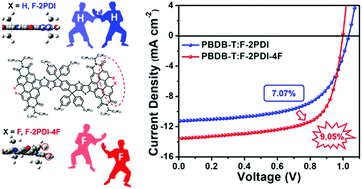Tailoring the molecular geometry of polyfluoride perylene diimide acceptors towards efficient organic solar cells†
Abstract
By analyzing the photovoltaic parameters of organic solar cells based on perylene diimide (PDI) acceptors, we found that the power conversion efficiencies (PCEs) showed an approximately positive linear correlation with the fill factors (FFs), which were mainly determined by the morphology. To tune the morphology impacted by the molecular geometry of the donor and the acceptor, a fully fused PDI derivative F-2PDI-4F, wherein the adjacent bay positions of PDI were substituted by fluorine atoms, was rationally designed and synthesized. The repulsion of F⋯F reduced the coplanarity of PDI and created a dihedral angle of 12.6°, which endowed F-2PDI-4F with relatively weak crystallinity as compared to its analogue F-2PDI without fluorination. These two acceptors were incorporated with two polymer donors, PTB7-Th and PBDB-T, with varied crystallinities to fabricate a solar cell device. The performance showed that the combination of a highly crystalline donor (acceptor) and a weakly crystalline acceptor (donor) was beneficial for the improvement in FF due to the improved microstructure of the blend films. Thus, the device with PBDB-T and F-2PDI-4F achieved a high FF of 66.9% and the best PCE of 9.05%. F-2PDI-4F is one of the few examples among numerous PDI acceptors that can achieve PCEs exceeding 9%. Our study provides a fruitful avenue for applying electrostatic repulsion to modulate molecular geometry, consequently improving the optoelectronic properties of organic semiconductors.



 Please wait while we load your content...
Please wait while we load your content...